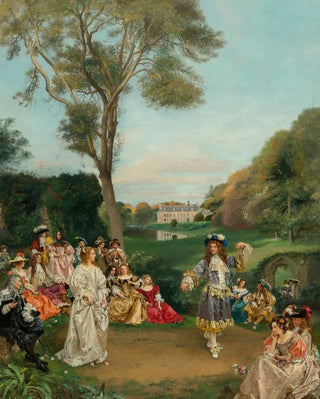Art print | La danse Château de Kerduel Comte de Champagny - Gustave Jean Jacquet


View from behind

Frame (optional)
In the rich and captivating universe of art, certain works stand out for their ability to evoke deep emotions and transport the viewer to another time. "The Dance Château de Kerduel Count of Champagny" by Gustave Jean Jacquet is one of those creations that, through its brilliance and poetry, invites us to immerse ourselves in a world of grace and beauty. This art print, faithful to the original, reminds us of the importance of dance in artistic expression, while highlighting the social and cultural life of 19th-century France. Through this piece, we discover not only a frozen moment in time but also an invitation to celebrate joy and elegance.
Style and uniqueness of the work
Gustave Jean Jacquet's style is distinguished by striking realism, combined with a romantic sensitivity that gives his works a unique atmosphere. In "The Dance Château de Kerduel Count of Champagny," every detail is carefully crafted, from the flamboyant costumes of the dancers to the joyful expressions that illuminate their faces. The dynamic composition of the piece, where the fluid movements of the characters seem almost tangible, creates a sense of life and motion. Jacquet excels in capturing the moment, and this outdoor dance scene, set in a majestic setting, demonstrates his talent for immortalizing moments of conviviality and celebration. The subtle use of light and shadow further enhances the depth and visual richness of this work, making each glance a new discovery.
The artist and his influence
Gustave Jean Jacquet, a 19th-century French painter, made his mark by his innovative approach and commitment to depicting everyday life. Strongly influenced by the Romantic movement, he integrated elements of nature and French culture into his works, creating a dialogue between art and society of his time. Jacquet was also a passionate advocate of genre painting, seeking to immortalize scenes of daily life with remarkable precision and sensitivity. His work has inspired many contemporary artists,

Matte finish

View from behind

Frame (optional)
In the rich and captivating universe of art, certain works stand out for their ability to evoke deep emotions and transport the viewer to another time. "The Dance Château de Kerduel Count of Champagny" by Gustave Jean Jacquet is one of those creations that, through its brilliance and poetry, invites us to immerse ourselves in a world of grace and beauty. This art print, faithful to the original, reminds us of the importance of dance in artistic expression, while highlighting the social and cultural life of 19th-century France. Through this piece, we discover not only a frozen moment in time but also an invitation to celebrate joy and elegance.
Style and uniqueness of the work
Gustave Jean Jacquet's style is distinguished by striking realism, combined with a romantic sensitivity that gives his works a unique atmosphere. In "The Dance Château de Kerduel Count of Champagny," every detail is carefully crafted, from the flamboyant costumes of the dancers to the joyful expressions that illuminate their faces. The dynamic composition of the piece, where the fluid movements of the characters seem almost tangible, creates a sense of life and motion. Jacquet excels in capturing the moment, and this outdoor dance scene, set in a majestic setting, demonstrates his talent for immortalizing moments of conviviality and celebration. The subtle use of light and shadow further enhances the depth and visual richness of this work, making each glance a new discovery.
The artist and his influence
Gustave Jean Jacquet, a 19th-century French painter, made his mark by his innovative approach and commitment to depicting everyday life. Strongly influenced by the Romantic movement, he integrated elements of nature and French culture into his works, creating a dialogue between art and society of his time. Jacquet was also a passionate advocate of genre painting, seeking to immortalize scenes of daily life with remarkable precision and sensitivity. His work has inspired many contemporary artists,






